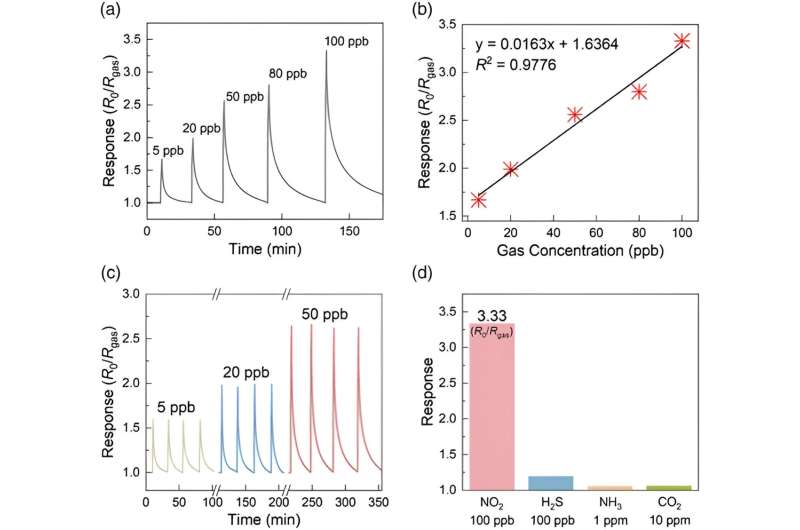
Researchers on the Korea Analysis Institute of Requirements and Science developed a poisonous gasoline sensor with the world’s highest sensitivity. This sensor can exactly monitor nitrogen dioxide (NO2), a poisonous gasoline within the ambiance, at room temperature with low energy consumption and ultra-high sensitivity. It may be utilized to various fields, equivalent to detection of residual gases throughout semiconductor manufacturing course of and analysis on electrolysis catalysts.
NO2, produced by the high-temperature combustion of fossil fuels and primarily emitted via car exhaust or manufacturing unit smoke, contributes to a rise in mortality on account of air air pollution. In South Korea, the annual common focus of NO2 within the air is regulated to be 30 ppb or decrease by presidential decree. Extremely delicate sensors, due to this fact, are required to precisely detect gases at extraordinarily low concentrations.
In current instances, using poisonous gases which might be probably deadly to people has been on the rise as a result of improvement of high-tech industries, together with semiconductor manufacturing. Whereas some laboratories and factories have adopted semiconductor-type sensors for security, the problem lies of their low response sensitivity, making them unable to detect poisonous gases that will even be perceptible to the human nostril. To extend the sensitivity, they devour lots of vitality ultimately as a result of they have to function at excessive temperatures.
The newly developed sensor, a next-generation semiconductor-type poisonous gasoline sensor based mostly on superior supplies, displays considerably improved efficiency and value in comparison with standard sensors. With its excellent sensitivity to chemical reactions, the brand new sensor can detect NO2 far more sensitively than beforehand reported semiconductor-type sensors, a sensitivity that’s 60 instances greater. Furthermore, the novel sensor consumes minimal energy working at room temperature, and its optimum semiconductor manufacturing course of allows large-area synthesis at low temperatures, thereby lowering fabrication prices.

The important thing to the know-how lies within the MoS2 nanobranch materials developed by KRISS. Not like the traditional 2D flat construction of MoS2, this materials is synthesized in a 3D construction resembling tree branches, thereby enhancing the sensitivity. Apart from its power of uniform materials synthesis on a big space, it will possibly create a 3D construction by adjusting the carbon ratio within the uncooked materials with out further processes.
The KRISS Semiconductor Built-in Metrology Staff has experimentally demonstrated that their gasoline sensor can detect NO2 within the ambiance at concentrations as little as 5 ppb. The calculated detection restrict of the sensor is 1.58 ppt, marking the world’s highest stage of sensitivity.
This achievement allows exact monitoring of NO2 within the ambiance with low energy consumption. The sensor not solely saves time and value but in addition provides wonderful decision. It’s anticipated to contribute to analysis on enhancing atmospheric situations by detecting annual common concentrations of NO2 and monitoring real-time modifications.
One other attribute of this know-how is its capability to regulate the carbon content material within the uncooked materials in the course of the materials synthesis stage, thereby altering the electrochemical properties. This may be utilized to develop sensors able to detecting gases aside from NO2, equivalent to residual gases produced in the course of the semiconductor manufacturing processes. The wonderful chemical reactivity of the fabric may also be exploited to reinforce the efficiency of electrolysis catalysts for hydrogen manufacturing.
Dr. Jihun Mun, a senior researcher of the KRISS Semiconductor Built-in Metrology Staff, mentioned, “This know-how, which overcomes the constraints of standard gasoline sensors, is not going to solely meet authorities rules but in addition facilitate exact monitoring of home atmospheric situations. We are going to proceed follow-up analysis in order that this know-how might be utilized to the event of assorted poisonous gasoline sensors and catalysts, extending past the monitoring of NO2 within the ambiance.”
Extra info:
Jeongin Music et al, MOCVD of Hierarchical C‐MoS2 Nanobranches for ppt‐Degree NO2 Detection, Small Constructions (2023). DOI: 10.1002/sstr.202200392
Quotation:
Novel poisonous gasoline sensor improves the restrict of nitrogen dioxide detection (2023, December 29)
retrieved 30 December 2023
from https://phys.org/information/2023-12-toxic-gas-sensor-limit-nitrogen.html
This doc is topic to copyright. Other than any honest dealing for the aim of personal examine or analysis, no
half could also be reproduced with out the written permission. The content material is offered for info functions solely.

